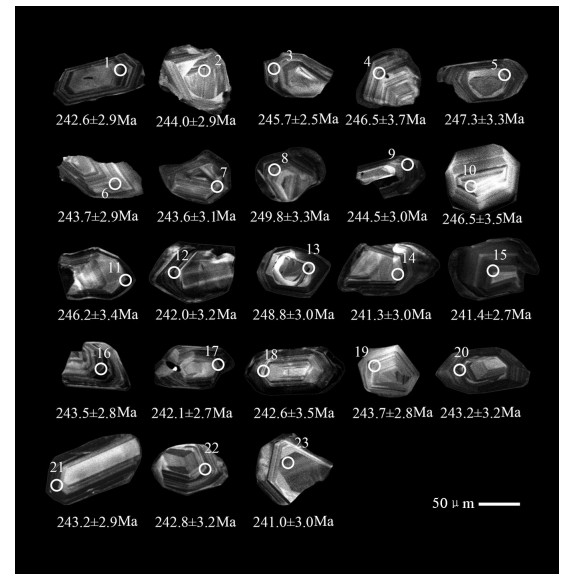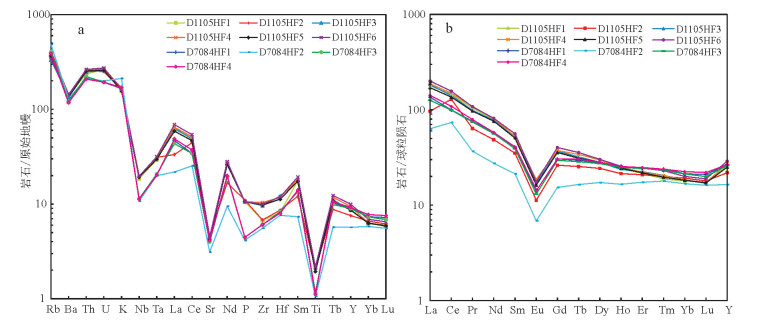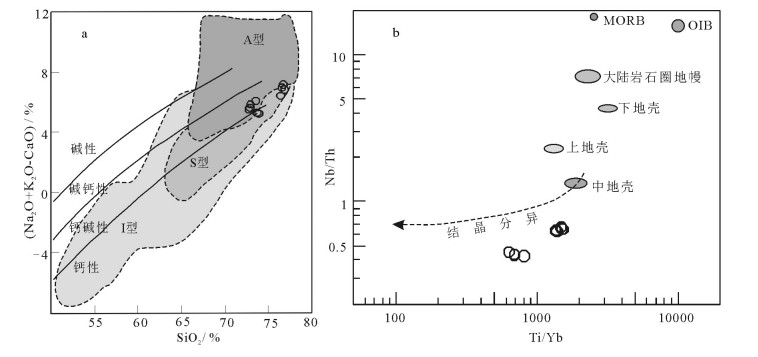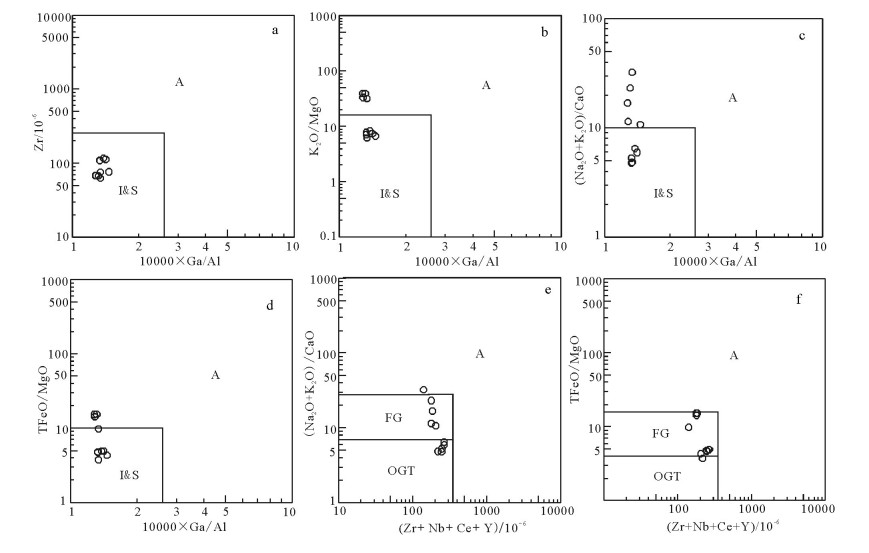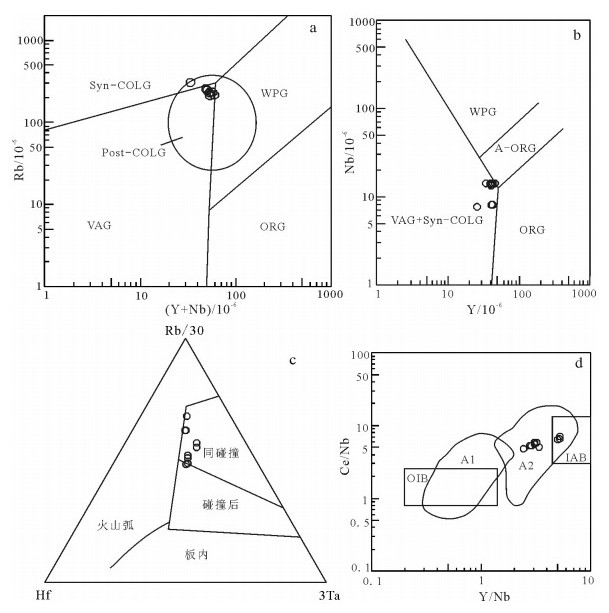Age and geochemical characteristics of Malasongduo Formation rhyolite in Riza Mountain, east Tibet, and its geological significance
-
摘要:
为确定藏东日扎山一带马拉松多组流纹岩的形成时代及成岩构造环境,探讨古特提斯洋闭合时间,应用LA-ICP-MS方法对其进行锆石U-Pb精确定年,并开展岩石学和地球化学研究。结果表明,该区流纹岩岩浆锆石206Pb/238U年龄加权平均值为244±1.2Ma,较精确地限定了马拉松多组流纹岩的形成时代,为中三叠世早期。岩相学及地球化学研究结果显示,马拉松多组流纹岩具高硅(SiO2=72.72%~76.88%),富碱((K2O+Na2O)=6.64%~7.41%,K2O>Na2O),过铝质(Al2O3=11.76%~13.03%,A/CNK=1.17~1.31)特征;岩石富集大离子亲石元素K、Rb,高场强元素Th、U,而亏损大离子亲石元素Sr和Ba,高场强元素Nb、Ta、P、Zr、Hf、Ti等;稀土元素配分模式表现出轻稀土元素富集(LREE/HREE=1.93~2.89),轻稀土元素分馏程度稍高于重稀土元素的右倾V字形分布模式,具有明显的负Eu异常(δEu=0.36~0.41);其成因可能与幔源岩浆的底侵和加厚地壳的减薄有关,是幔源基性岩浆底侵导致地壳物质脱水发生部分熔融的产物,即主要是陆壳和硅铝质源岩部分熔融形成的,岩浆在上升过程中经历了结晶分异作用。其化学性质具有S型向A型流纹岩演化的趋势,以及同碰撞弧火山岩与碰撞后A型流纹岩的双重特性。综合研究认为,研究区在早中三叠世处于弧-陆碰撞后活动大陆边缘短暂的后造山伸展构造环境,古特提斯洋(金沙江洋)在此之前已经闭合。
Abstract:In order to determine the formation age and tectonic environment of east Tibetan Malasongduo Formation rhyolite and provide new evidence for studying ancient Tethys closing time, the authors applied the LA-ICP-MS method for the precise zircon U-Pb dating and studied petrology and geochemistry. The results show that the weighted average 206Pb/238U age of rhyolite magma in this area is 244 ±1.2Ma (MSWD=0.59), which accurately defines the formation age of the Malasongduo Formation rhyolite, i.e., Early-Middle Triassic. Petrographic and geochemical studies show that Malasongduo Formation rhyolite has high silica (SiO2=72.72%~76.88%) and alkali (ALK (K2O+Na2O)=6.64%~7.41%, K2O>Na2O), and exhibits peraluminous nature (Al2O3=11.76%~13.03%, A/CNK=1.17~1.31); the rocks are enriched in large ion lithophile elements K and Rb, and high field strength elements Th and U, but depleted in large ion lithophile elements Sr and Ba, and high field strength elements such as Nb, Ta, P, Zr, Hf and Ti; REE patterns show that LREE is enriched (LREE/HREE=1.93~2.89), light rare earth elements (LREE) is slightly higher than the degree of fractionation of heavy rare earth elements (HREE), and there exist right-inclined V-shaped distribution and obvious negative Eu anomalies (Eu=0.36~0.41). The genesis of the rocks may be related to the underplating of the mantle derived magma and the thinning of the thickening crust. They were formed by the mantle derived basic magma underplating resulting in dehydration of crustal material and partial melting. They were mainly formed by partial melting of continental crust and aluminosilicate source rocks, and the magma underwent crystallization differentiation during the process of rising. The chemical properties have the evolution trend of S type to A type rhyolite, and have the dual characteristics of the syn-collisional arc volcanic rocks and the post collisional A type rhyolite. According to the comprehensive study, the study area was in a short post orogenic extensional tectonic environment on the post collisional active continental margin in the Early-Middle Triassic period, and the ancient Tethys Ocean (Jinshajiang Ocean) had been closed before that.
-
Key words:
- rhyolite /
- Malasongduo Group /
- geochronology /
- geochemistry /
- Tibet /
- Riza Mountain
-

-
图 7 日扎山流纹岩岩石成因类型判别图解[31]
Figure 7.
表 1 日扎山马拉松多组流纹岩LA-ICP-MS锆石U-Th-Pb同位素分析结果
Table 1. LA-ICP-MS zircon U-Th-Pb dating results for rhyolites from the Malasongduo Formation, Riza Mountain
测点 含量/10–6 Th/U 同位素比值 年龄/Ma Pb 232Th 238U 207Pb/206pb ±1σ 207Pb/235U ±1σ 206Pb/238U ±1σ 207Pb/206Pb ±1σ 207Pb/235U ±1σ 206Pb/238U ±1σ 1 30.6 120.9 302.7 0.40 0.052 0.002 0.274 0.011 0.0384 0.0005 333.4 95.4 245.8 8.7 242.6 2.9 2 60.6 253.5 420.6 0.60 0.052 0.002 0.279 0.009 0.0386 0.0005 294.5 74.1 250.0 7.4 244.0 2.9 3 97.4 391.1 687.9 0.57 0.057 0.002 0.303 0.008 0.0389 0.0004 479.7 63.0 268.5 6.2 245.7 2.5 4 20.7 81.2 172.9 0.47 0.051 0.003 0.273 0.014 0.0390 0.0006 255.6 119.4 244.9 11.1 246.5 3.7 5 44.8 147.9 560.9 0.26 0.051 0.002 0.276 0.009 0.0391 0.0005 255.6 74.1 247.9 7.3 247.3 3.3 6 47.2 175.6 469.3 0.37 0.052 0.002 0.279 0.009 0.0385 0.0005 305.6 78.7 250.2 7.1 243.7 2.9 7 30.4 112.5 309.0 0.36 0.051 0.002 0.268 0.009 0.0385 0.0005 227.8 81.5 241.2 7.4 243.6 3.1 8 22.4 81.0 204.9 0.40 0.055 0.003 0.298 0.015 0.0395 0.0005 394.5 109.2 264.7 11.5 249.8 3.3 9 45.6 151.1 550.7 0.27 0.049 0.002 0.264 0.010 0.0387 0.0005 164.9 81.5 237.5 7.6 244.5 3.0 10 27.8 113.2 222.5 0.51 0.051 0.002 0.269 0.012 0.0390 0.0006 231.6 103.7 242.1 9.4 246.5 3.5 11 22.8 92.5 175.0 0.53 0.057 0.003 0.306 0.017 0.0389 0.0006 500.0 122.2 270.8 13.3 246.2 3.4 12 25.9 105.5 191.5 0.55 0.053 0.003 0.278 0.013 0.0383 0.0005 342.7 111.1 249.4 10.0 242.0 3.2 13 44.8 121.3 634.0 0.19 0.052 0.001 0.284 0.008 0.0393 0.0005 298.2 64.8 253.6 6.2 248.8 3.0 14 40.4 167.5 279.7 0.60 0.053 0.002 0.276 0.012 0.0381 0.0005 316.7 101.8 247.7 9.6 241.3 3.0 15 48.7 193.7 370.0 0.52 0.051 0.002 0.270 0.011 0.0381 0.0004 235.3 88.9 242.8 8.7 241.4 2.7 16 44.3 133.4 604.4 0.22 0.053 0.001 0.281 0.008 0.0385 0.0004 320.4 63.0 251.1 6.0 243.5 2.8 17 33.9 107.6 441.9 0.24 0.050 0.002 0.266 0.009 0.0383 0.0004 205.6 79.6 239.3 7.5 242.1 2.7 18 26.9 96.8 321.3 0.30 0.054 0.002 0.285 0.013 0.0383 0.0006 368.6 106.5 254.4 10.4 242.6 3.5 19 32.0 103.4 386.5 0.27 0.050 0.002 0.265 0.010 0.0385 0.0004 189.0 92.6 238.4 8.4 243.7 2.8 20 49.2 198.5 366.5 0.54 0.051 0.002 0.267 0.010 0.0384 0.0005 220.4 87.0 240.3 8.1 243.2 3.2 21 36.6 135.7 385.9 0.35 0.051 0.002 0.272 0.010 0.0384 0.0005 257.5 86.1 244.4 7.8 243.2 2.9 22 38.2 160.7 281.9 0.57 0.049 0.002 0.260 0.011 0.0384 0.0005 166.8 98.1 235.0 9.2 242.8 3.2 23 47.4 196.1 340.5 0.58 0.050 0.002 0.262 0.010 0.0381 0.0005 183.4 119.4 236.6 8.1 241.0 3.0 表 2 马拉松多组流纹岩主量、微量和稀土元素分析结果
Table 2. Major, trace and rare earth elements analytical results of the rhyolites from the Malasongduo Formation
样号 D1105HF-1 D1105HF-2 D1105HF-3 D1105HF-4 D1105HF-5 D1105HF-6 D7084HF1 D7084HF2 D7084HF3 D7084HF4 SiO2 73.71 73.53 72.72 72.96 73.88 72.91 76.43 76.73 76.88 76.58 TiO2 0.46 0.45 0.46 0.47 0.42 0.47 0.25 0.23 0.25 0.24 Al2O3 12.69 13 12.88 13.03 12.63 12.97 11.76 11.82 11.78 11.88 Fe2O3 0.86 1.26 1.11 0.98 1 0.96 1.84 1.84 1.88 1.8 FeO 1.79 1.69 1.91 1.81 1.72 2.06 0.27 0.11 0.11 0.17 MnO 0.037 0.036 0.04 0.042 0.036 0.043 0.021 0.01 0.014 0.017 MgO 0.76 0.73 0.68 0.61 0.61 0.66 0.15 0.2 0.13 0.13 CaO 1.38 0.63 1.29 1.07 1.39 1.14 0.62 0.23 0.31 0.44 Na2O 1.98 1.83 1.96 1.84 1.91 1.85 2.08 1.01 2.03 2.3 K2O 4.71 4.9 4.86 5.08 4.73 4.93 4.98 6.39 5.12 5.11 P2O5 0.23 0.24 0.23 0.23 0.23 0.23 0.097 0.09 0.097 0.097 H2O- 0.12 0.12 0.12 0.14 0.18 0.1 0.08 0.14 0.08 0.1 烧失量 1.06 1.52 1.4 1.34 1.14 1.28 1.14 1.2 1.06 0.98 总计 99.67 99.82 99.54 99.46 99.70 99.50 99.64 99.86 99.66 99.74 ALK 6.69 6.73 6.82 6.92 6.64 6.78 7.06 7.40 7.15 7.41 K2O/Na2O 2.38 2.68 2.48 2.76 2.48 2.66 2.39 6.33 2.52 2.22 A/CNK 1.17 1.37 1.19 1.24 1.17 1.24 1.18 1.31 1.25 1.17 σ 1.46 1.48 1.57 1.60 1.43 1.54 1.49 1.62 1.51 1.64 SI 7.52 7.01 6.46 5.91 6.12 6.31 1.61 2.09 1.40 1.37 DI 85.57 87.61 85.56 86.57 85.93 85.71 92.28 93.32 93.56 93.49 Cs 3.68 5.89 3.74 4.14 3.64 3.95 2.91 5.46 2.80 2.82 Rb 228 261 210 233 233 216 245 307 254 246 Sr 92.8 98.1 89.3 92.2 90.1 95.0 86.3 65.6 84.4 86.7 Ba 963 1008 955 1003 939 1005 816 910 854 824 Pb 35.9 29.1 36.5 36.9 34.8 36.6 19.8 26.0 19.5 19.0 Ga 17.0 19.0 17.1 18.0 16.8 18.3 15.1 15.8 15.5 15.2 Nb 13.2 14.1 14.1 14.0 13.7 14.0 8.02 7.65 8.14 8.02 Ta 1.20 1.28 1.25 1.29 1.22 1.30 0.83 0.82 0.85 0.83 Zr 75.1 76.0 108 116 109 112 68.0 62.2 67.6 68.0 Hf 2.52 2.67 3.74 3.63 3.48 3.67 2.47 2.35 2.57 2.47 Th 20.2 22.2 21.2 21.7 21.6 22.4 18.4 18.1 18.8 17.7 V 21.2 23.6 22.8 24.7 20.3 24.1 7.41 8.16 7.38 7.32 Cr 14.1 14.2 14.2 14.3 12.5 14.1 8.14 4.17 5.19 5.59 Co 5.14 4.91 5.72 6.37 4.92 6.05 3.42 2.14 3.01 3.00 Ni 7.45 8.44 7.84 8.74 6.88 7.42 4.09 2.35 2.56 2.42 Sc 7.18 8.08 7.33 7.56 7.00 7.94 4.47 4.26 4.68 4.59 U 5.52 5.23 5.39 5.63 5.45 5.74 4.07 4.20 4.07 4.06 La 42.2 22.9 43.3 44.4 40.5 47.4 32.1 15.0 29.8 33.5 Ce 89.3 79.0 86.4 91.2 83.1 96.0 60.9 45.0 60.7 66.2 Pr 9.91 6.06 9.39 10.3 9.21 10.2 7.19 3.49 7.07 7.47 Nd 37.0 22.7 36.2 37.5 35.5 38.0 26.8 12.8 26.3 27.0 Sm 7.86 5.36 8.06 8.11 7.73 8.58 6.21 3.27 5.99 6.22 Eu 0.99 0.65 0.97 1.08 0.94 1.02 0.82 0.40 0.76 0.83 Gd 7.41 5.39 7.59 7.68 7.32 8.26 6.28 3.16 6.06 6.24 Tb 1.18 0.95 1.20 1.27 1.16 1.33 1.11 0.62 1.07 1.14 Dy 7.07 6.17 7.14 7.55 7.17 7.66 7.11 4.38 6.93 7.15 Ho 1.37 1.21 1.34 1.41 1.38 1.45 1.41 0.94 1.41 1.44 Er 3.57 3.44 3.71 3.67 3.62 4.04 3.99 2.88 4.02 4.10 Tm 0.48 0.51 0.52 0.52 0.50 0.59 0.61 0.46 0.60 0.61 Yb 3.05 3.26 3.11 3.11 3.10 3.40 3.62 2.85 3.62 3.81 Lu 0.44 0.46 0.43 0.44 0.44 0.48 0.53 0.41 0.51 0.56 Y 40.3 34.4 39.4 43.0 39.3 45.4 41.8 25.8 40.8 41.9 ∑REE 252.16 192.34 248.73 261.38 240.92 273.86 200.48 121.49 195.70 208.21 LREE 187.29 136.58 184.33 192.74 176.92 201.27 134.04 79.99 130.66 141.21 HREE 64.87 55.76 64.40 68.65 64.00 72.59 66.44 41.50 65.04 67.00 LR/HR 2.89 2.45 2.86 2.81 2.76 2.77 2.02 1.93 2.01 2.11 (La/Yb)N 9.93 5.03 10.01 10.25 9.36 10.00 6.36 3.77 5.92 6.30 (La/Sm)N 3.47 2.76 3.47 3.54 3.38 3.57 3.34 2.96 3.22 3.48 (Gd/Yb)N 2.01 1.37 2.02 2.04 1.95 2.01 1.43 0.92 1.39 1.35 δEu 0.39 0.37 0.38 0.41 0.38 0.37 0.40 0.37 0.38 0.40 δCe 1.03 1.61 1.00 1.01 1.01 1.02 0.94 1.47 0.99 0.98 注:主量元素含量单位为%,微量和稀土元素含量单位为10-6 -
[1] 邓军, 侯增谦, 莫宣学, 等.三江特提斯复合造山与成矿作用[J].矿床地质, 2010, 29(1):37-42. doi: 10.3969/j.issn.0258-7106.2010.01.005
[2] 刘增乾, 李兴振, 叶庆同, 等.三江地区构造岩浆带的划分与矿产分布规律[M].北京:地质出版社, 1993:1-246.
[3] 莫宣学, 路凤香, 沈上越, 等.三江特提斯火山作用与成矿[M].北京:地质出版社, 1993:1-267.
[4] 潘桂棠, 陈智梁, 李兴振, 等.东特提斯地质构造形成演化[M].北京:地质出版社, 1997:1-218.
[5] 钟大赉, 等.滇川西部古特提斯造山带[M].北京:地质出版社, 1998:1-231.
[6] 李兴振, 刘文均, 王义昭, 等.西南三江地区特提斯构造演化与成矿(总论)[M].北京:地质出版社, 1999:1-256.
[7] 潘桂棠, 徐强, 侯增谦, 等.西南"三江"多岛弧造山过程、成矿系统与资源评价[M].北京:地质出版社, 2003:1-420.
[8] 侯增谦, 钟大赉, 邓万明.青藏高原东缘斑岩铜钼金成矿带的构造模式[J].中国地质, 2004, 31(1):1-14. http://d.old.wanfangdata.com.cn/Periodical/zgdizhi200401001
[9] 邓军, 王长明, 李龚健.三江特提斯叠加成矿作用样式及过程[J].岩石学报, 2012, 28(5):1349-1361. http://d.old.wanfangdata.com.cn/Periodical/ysxb98201205001
[10] 吴根耀, 王晓鹏, 钟大赉, 等.川滇藏交界区二叠纪-早三叠世的两套弧火山岩[J].地质科学, 2000, 35(3):350-362. doi: 10.3321/j.issn:0563-5020.2000.03.010
[11] 李文昌, 潘桂棠, 侯增谦, 等.西南"三江"多岛弧盆-碰撞造山成矿理论与勘查技术[M].北京:地质出版社, 2010:1-266.
[12] 邓军, 王长明, 李文昌, 等.三江特提斯复合造山与成矿作用研究态势及启示[J].地学前缘, 2014, 21(1):52-64. http://d.old.wanfangdata.com.cn/Periodical/dxqy201401006
[13] 邹光富, 毛英, 毛琼, 等.西南三江地区大地构造演化与成矿作用[J].矿物岩石, 2017, 37(1):15-29. http://d.old.wanfangdata.com.cn/Conference/6824031
[14] 邓军, 王庆飞, 李龚健. 2016.复合造山和复合成矿系统:三江特提斯例析[J].岩石学报, 2016, 32(8):2225-2247.
[15] 姚华舟, 徐安武, 汤朝阳, 等.西藏东部早-中三叠世火山-沉积盆地地质特征[J].华南地质与矿产, 2006, 3:41-47. doi: 10.3969/j.issn.1007-3701.2006.03.007
[16] 西藏自治区地质矿产局.西藏自治区岩石地层[M].武汉:中国地质大学出版社, 1997:1-302.
[17] 王立全, 潘桂棠, 李定谋, 等.江达-维西陆缘火山弧的形成演化及成矿作用[J].沉积与特提斯地质, 2000, 20(2):1-17. doi: 10.3969/j.issn.1009-3850.2000.02.001
[18] 潘桂棠, 丁俊, 姚冬生, 等.青藏高原及邻区1:1500000地质图说明书[M].成都:成都地图出版社, 2004:1-58.
[19] Liu Y S, Hu Z C, Gao S, et al. In situ analysis of major and trace elements of anhydrous minerals by LA-ICP-MS without applying an internal standard[J]. Chemical Geology, 2008, 257(1/2):34-43. http://www.wanfangdata.com.cn/details/detail.do?_type=perio&id=babd721ac13e2675d9485b52683be64c
[20] Liu Y S, Hu Z C, Zong K Q, et al. Reappraisement and refinement of zircon U-Pb isotope and trace element analyses by LA-ICP-MS[J]. Chinese Science Bulletin, 2010, 55(15):1535-1546. doi: 10.1007/s11434-010-3052-4
[21] Ludwig K R. User's Manual for Isoplot/Ex, Version 3.00. a geochronological toolkit for Microsoft Excel[J]. Berkeley Geochronology Center Special Publication, 2003, 4(2):1-70.
[22] Liu Y S, Zong K Q, Kelemen P B, et al. Geochemistry and magmatic history of eclogites and ultramafic rocks from the Chinese continental scientific drill hole:subduction and ultrahighpressure metamorphism of lower crustal cumulates[J]. Chemical Geology, 2008, 247:133-153. doi: 10.1016/j.chemgeo.2007.10.016
[23] 孟凡超, 刘嘉麒, 李明, 等.松辽盆地徐家围子营城组流纹岩地球化学特征及构造指示意义[J].岩石学报, 2010, 26(1):227-241. http://d.old.wanfangdata.com.cn/Periodical/ysxb98201001025
[24] 孟凡超, 路玉林, 刘嘉麒, 等.松辽盆地营城组两类酸性火山岩地球化学特征与成因[J].岩石学报, 2013, 29(8):2731-2745. http://d.old.wanfangdata.com.cn/Periodical/ysxb98201308010
[25] Le Bas M J, Le Maitre R W. A chemical classification of volcanic rocks based on the total alkali-silica diagram[J]. Journal of petrology, 1986, 27(3):745-750. doi: 10.1093/petrology/27.3.745
[26] Middlemost E A K. Naming materials in the magma/igneous rock system[J]. Earth-Science Reviews, 1994, 37:215-224. doi: 10.1016/0012-8252(94)90029-9
[27] Irvine T N, Baragar W R A. A guide to the chemical classification of the common volcanic rocks[J]. Canadian Journal of Earth Sciences, 1971, 8(5):523-548. doi: 10.1139/e71-055
[28] Maniar P D, Piccoli P M. Tectonic discrimination of granitoids[J]. Geological Society of America Bulletin, 1989, 101(5):635-643. doi: 10.1130/0016-7606(1989)101<0635:TDOG>2.3.CO;2
[29] Le Maitre R W, Bakteman P, Dudek A, et al. A classification of igneous rocks and glossary of terms:recommendations of the international union of geological sciences subcommission on the systematics of igneous rocks[M]. Oxford:Blackwell Scientific Publications, 1989:1-193.
[30] Rickwood P C. Boundary lines within petrologic diagrams which use oxides major and minor elements[J]. Lithos, 1989, 22:247-263. doi: 10.1016/0024-4937(89)90028-5
[31] Whalen J B, Currie K L, Chappell B W. A-type granites:geochemical characteristics, discrimination and petrogenesis[J]. Contributions to Mineralogy and Petrology, 1987, 95(4):407-419. doi: 10.1007/BF00402202
[32] Sun S S, McDonoungh W F. Chemical and isotopic systematic of oceanic basalts:implications for mantle composition and processes[J]. Geological Society Special Publication, 1989, 42:313-345. doi: 10.1144/GSL.SP.1989.042.01.19
[33] 李杰, 吕新彪, 陈超, 等.大兴安岭中段塔尔气地区流纹岩年龄、地球化学特征及其地质意义[J].地质通报, 2016, 35(6):906-918. doi: 10.3969/j.issn.1671-2552.2016.06.008 http://dzhtb.cgs.cn/gbc/ch/reader/view_abstract.aspx?file_no=20160608&flag=1
[34] 刘一鸣, 李才, 王明, 等.藏北羌塘盆地望湖岭组流纹岩地球化学特征及其地质意义[J].地质通报, 2014, 30(11):1759-1767. doi: 10.3969/j.issn.1671-2552.2014.11.012 http://www.cnki.com.cn/Article/CJFDTotal-ZQYD201411012.htm
[35] 张祥信, 高永丰, 雷世和.内蒙古中部红格尔地区白音高老组流纹岩地球化学特征及成因[J].现代地质, 2016, 30(5):950-960. doi: 10.3969/j.issn.1000-8527.2016.05.002
[36] 李莉, 白云山, 牛志军, 等.藏北羌塘中部劳日特错花岗斑岩体的特征及构造意义[J].地质通报, 2004, 23(2/3):1040-1045. http://d.old.wanfangdata.com.cn/Periodical/zgqydz200409030
[37] 王中刚, 于学元, 赵振华.稀土元素地球化学[M].北京:科学出版社, 1989:133-246.
[38] Rudnick R L, Gao S. The composition of the continental crust[C]//Rudnick R L. Treatise on Geochemistry. The Crust. Oxford: Elsevier-Pergamon, 2003: 1-64.
[39] 李红英, 周志广, 张达, 等, 内蒙古西乌旗格尔楚鲁晚三叠世流纹岩年代学、地球化学特征及其地质意义[J].矿物岩石地球化学通报, 2015, 34(3):546-555. doi: 10.3969/j.issn.1007-2802.2015.03.011
[40] 尹志刚, 张跃龙, 杜玉春, 大兴安岭北部早白垩世上库力组流纹岩的地球化学特征及成因[J].吉林大学学报(地球科学版), 2013, 43(3):788-796. http://d.old.wanfangdata.com.cn/Periodical/cckjdxxb201303013
[41] 李宁波, 单强, 张永平, 等.西天山阿吾拉勒地区A型流纹斑岩的初步研究[J].大地构造与成矿学, 2012, 4:624-633. doi: 10.3969/j.issn.1001-1552.2012.04.016
[42] 邱检生, 俆夕生.火成岩岩石学[M].北京:科学出版社, 2010:207-235.
[43] Frost B R, Barnes C G, Collins W J, et al. A geochemical classification for granitic rocks[J]. Journal of Petrology, 2001, 42(11):2033-2048. doi: 10.1093/petrology/42.11.2033
[44] 李献华, 周汉文, 李正祥, 等.川西新元古代双峰式火山岩成因的微量元素和Sm-Nd同位素制约及其大地构造意义[J].地质科学, 2002, 3:264-276. doi: 10.3321/j.issn:0563-5020.2002.03.002
[45] 陈根文, 邓腾, 刘睿, 等.西天山阿吾拉勒地区二叠系塔尔得套组双峰式火山岩地球化学研究[J].岩石学报, 2015, (1):105-118. http://d.old.wanfangdata.com.cn/Periodical/ysxb98201501008
[46] 解开瑞, 巫建华, 祝洪涛, 等.大兴安岭南端芝瑞盆地流纹岩年代学、地球化学及岩石成因[J].地球化学, 2016, 45(3):249-267. doi: 10.3969/j.issn.0379-1726.2016.03.003
[47] 张本仁.大陆造山带地球化学研究:Ⅰ岩石构造环境地球化学判别的改进[J].西北地质, 2001, 3:1-17. http://d.old.wanfangdata.com.cn/Periodical/xbdz200103001
[48] Pearce J A, Harris N B W, Tindle A G. Trace element discrimination diagrams for the tectonic interpretation of granitic rocks[J]. Journal of Petrology, 1984, 25(4):956-983. doi: 10.1093/petrology/25.4.956
[49] Harris N B W, Pearce J A, Tindle A G. Geochemical characteristics of collision-zone agmatism[J]. Geological Society of London, Special Publication, 1986, 19:67-81. doi: 10.1144/GSL.SP.1986.019.01.04
[50] Eby G N. Chemical Subdivision of the A-type granitoids:petrologic and tectonic implications[J]. Geology, 1992, 20(7):641-644. doi: 10.1130/0091-7613(1992)020<0641:CSOTAT>2.3.CO;2
[51] 莫宣学, 邓晋福, 董方浏, 等.西南三江造山带火山岩-构造组合及其意义[J].高校地质学报, 2001, 7(2):121-138. doi: 10.3969/j.issn.1006-7493.2001.02.001
[52] Eklund O, Konopelko D, Rutanen H, et al. 1.8Ga Svecofennian post-collisional shoshonitic magmatism in the Fennoscandian shield[J]. Lithos, 1998, 45(1):87-108. http://www.wanfangdata.com.cn/details/detail.do?_type=perio&id=caac5ba2afbd18132533aec9d166d677
① 青海省区调综合大队. 1: 20万白玉县幅、雄松区幅区域地质调查报告.西藏自治区地质矿产局, 1992.
② 西藏自治区地质调查院. 1: 25万八宿县幅(H47C002001)、贡觉县幅(H47C002002)、然乌区幅(H47C003001)、芒康县幅(H47C003002)区域地质调查报告. 2007.
-



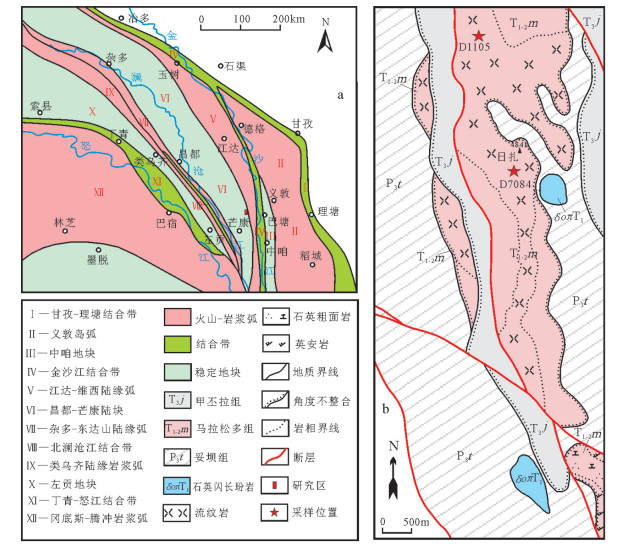
 下载:
下载:

